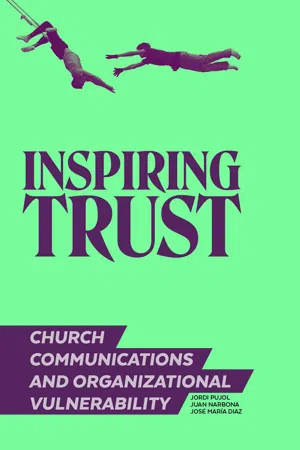
Inspiring Trust
Church Communications & Organizational Vulnerability
- 262 pages
- English
- ePUB (mobile friendly)
- Available on iOS & Android
Inspiring Trust
Church Communications & Organizational Vulnerability
About this book
Technology is furthering a swift and profound economic, social and cultural change: not only the digital economy and new information flows, but also personal habits and styles of life, even our relationships, are deeply shaped by technology. This ongoing new scenario poses some challenges to organizations that are called to be transparent and accountable, and to understand what to do in the digital ecosystem.As Pope Francis said, "what we are experiencing is not simply an epoch of changes, but an epochal change. We find ourselves living at a time when change is no longer linear, but epochal". Those words were pronounced just some months before the coronavirus pandemic, a global situation that worsened the weakening and increasing uncertainty of relationships brought about by the digital revolution. A new world was coming and old powers were losing control over it.The pandemic fostered societal fears. People didn't trust their leaders' capability to guide them or to take the right decisions. This lack of leadership put trust in institutions to the test, but that distrust was not something new. Statistics show that since the 90's, trust in some organizations that have been the backbone of society is plummeting. Cultural and social changes together with scandals and incoherence on the part of some groups led publics to evaluate organizations more rigorously than ever. A culture of suspicion toward political parties, financial institutions, trade unions, the media, and also – of course – the Church, has since then been the norm.
Frequently asked questions
- Essential is ideal for learners and professionals who enjoy exploring a wide range of subjects. Access the Essential Library with 800,000+ trusted titles and best-sellers across business, personal growth, and the humanities. Includes unlimited reading time and Standard Read Aloud voice.
- Complete: Perfect for advanced learners and researchers needing full, unrestricted access. Unlock 1.4M+ books across hundreds of subjects, including academic and specialized titles. The Complete Plan also includes advanced features like Premium Read Aloud and Research Assistant.
Please note we cannot support devices running on iOS 13 and Android 7 or earlier. Learn more about using the app.
Information
COMMUNICATING EFFECTIVELY IN HIGH-RISK ORGANIZATIONS:
LEARNING FROM HIGH RELIABILITY ORGANIZATIONS

Table of contents
- 00Presentation
- 01Narbona
- 02Gregory
- 03Sanders
- 04Mora
- 05Domingo
- 06Doyle
- 07Zollner
- 08Sturla
- 09Daniels
- 10Magalhaes
- 11Kelly
- 13Younger
- 14GonzalezAlorda
- 15Guillen
- 16Hoffman
- 17Ruffini